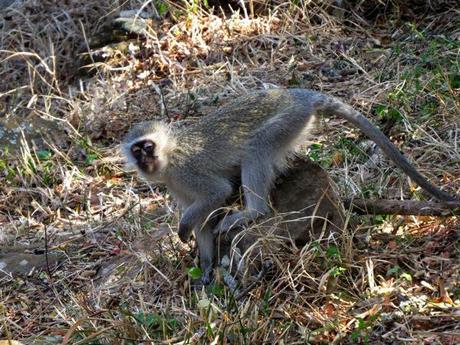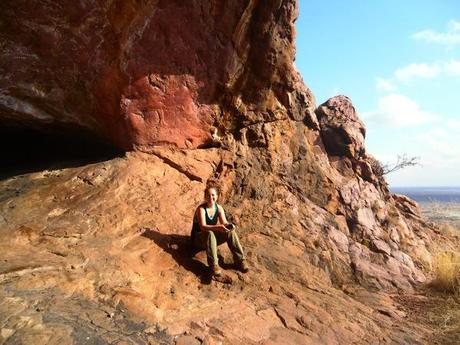This post is going to be all about the primates - vervet monkeys to be more specific. In the unlikely event that you haven't been following this blog religiously and therefore don't have any idea what I'm talking about right now, let me familiarize you with vervet monkeys.
Vervet:

I suppose there's also a second species I should introduce you to. Human.
More specifically, me:

My name is Leigh, and I've been a primate research assistant for the Primate and Predator Project for the past few months, working with both the samango and vervet monkeys. My time at Lajuma came to an end the last week of August, and I've been coping really well - watching a slideshow of photos from this summer on loop, armed with a tub of Ben and Jerry's in an attempt to soothe the pain. Just kidding. Kind of.
About 10 years ago when Durham University PhD student Erik Willems came to Lajuma, he began studying one of Lajuma's vervet troops and they became habituated to his presence. But that was many years ago. Long story short, the vervets aren't so cool with humans anymore. Since we haven't been able to follow them for ages, one of the things that Caroline, the current primate coordinator, wanted to get on top of this year was habituating the vervets so that we would be able to collect behavioral data on them within close proximity to and without disturbing the troop. But as I found out this summer, this is a task much easier said than done. As Kas, one of the babooners, so aptly put it, the vervets are like furry little ninjas. The first time I followed the vervets in June, I was with them for five hours. That was the longest that anyone had ever stayed with them at that point (as I quite liked to remind Kas, who had set the previous record when he stayed with them for two hours. Not that I'm competitive or anything). Despite this promising start, I soon discovered that without one of the individuals in the troop being collared, it was nearly impossible to find them. The second day that I was meant to follow the vervets, I spent six hours searching the forest and found no sign of them.
Things got about 3000% better once we collared Violet, one of the troop's dominent adult females, in early July (read the full story of how we collared her here http://primateandpredatorproject.wordpress.com/2014/07/30/to-catch-a-monkey/ ), as we were then able to use a VHF to locate the troop the evening before a follow day. Not that the VHF made it easy. It just made it less impossible. The first few follow days were rough. Confused and frightened, the vervets would sporadically dash away from me as I attempted to follow them. Seeing as staying with a troop of 50 samangos can be difficult if they all decide to sprint away from you at once, staying with a group of eight vervets when they do the same is challenging, to say the least. Moreover, the forest they tend to favor is often dense and thorny, which makes it hard to see the monkeys if they're any more than about 20 meters away. It also makes it painful. I think that the most scratched up I got the entire time I was at Lajuma was from following the vervets those first few days after Violet had been collared. But as frustrating as following Violet the vervet and her comrades could be, being a part of the habituation process was also extremely gratifying. I saw weekly progress, and by the time I left Lajuma, I could get within less than five meters of each individual and they would have no response to me. And their behavior became easier to predict - for example, I'm writing this blog post at midday, about 12:00, and I'd bet all the money I have on me (granted, that's only about 50 rand) that they're in the big fig tree in front of wilderness camp. That's not to say that this process is completed - I think that we still have a while to go before bush camp's resident troop of vervets can be deemed habituated. But we're getting there.
So. Vervet conclusions drawn thus far that could definitely be super wrong seeing as my presence might significantly impact their behavior:
- Their territory is much smaller that we initially thought it was. When I first started following the vervets, before Violet had been collared, we thought that their territory extended a kilometer or two away from bush camp, almost to a neighboring property called Diepkloof. The first time I followed vervets, they were in this area. However, we've since learned that this is a separate troop. We've now been following Violet's troop for over a month and they've not left the immediate bush camp vicinity, so we're pretty sure their territory is confined to that area.
- They are less vocal than samangos or baboons. This one is the most likely to have been influenced by my presence, I think - maybe they were nervous around me and so vocalized less? Anyway, the entire time I was with them I maybe heard three alarm calls (signaling danger to the rest of the troop) and two contact calls (communicating with the other moneys in the troop). Samangos will vocalize more than that in just one day.
- They exhibit social behaviors less frequently than samangos. Again, this could be due to the fact that they were wary of me. I did witness grooming between the females and sub-adults, but I never saw instances of playing or aggression.
- They start moving later and stop moving earlier than samangos.
- On average, they cover less ground in a day than do samangos (and definitely less than baboons).
- They're pretty darn cute. I feel pretty secure in this assertion.
I suppose that's it from me. I hope you'll forgive me for shamelessly using the end of this post for selfish purposes, but I'd like to give a shout-out to all of the inspiring people I spent the summer with. Katy, Sam, Caroline, Kyle, all of the other research assistants...thank you for making my time at Lajuma such an incredible experience. As Shannon rightly said in her farewell post, you all became like a family to me over the course of the past few months. I've learned so much from all of you and I can't wait to see what amazing things both the Primate and Predator Project and each of you individually get up to in the future. And of course a special thanks to the monkeys. Just in case we've been severely underestimating your abilities and you can in fact read, I wouldn't want to leave you out.
